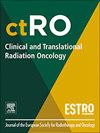IMRT时代局部区域晚期鼻咽癌同步放化疗加或不加辅助化疗的10年生存结果:一项根据高风险和低风险分层的回顾性队列研究
IF 2.7
3区 医学
Q3 ONCOLOGY
引用次数: 0
摘要
目的评价调强放疗(IMRT)时代局部区域晚期鼻咽癌(NPC)同步放化疗(CCRT)±辅助化疗(AC)治疗的10年生存结局,并评估AC对高危和低危患者生存的影响。方法本回顾性队列研究分析了2009-2012年477例非转移性鼻咽癌患者,CCRT + AC (n = 315)或CCRT单独治疗(n = 162)。采用已发表的预后模型将风险分层为高/低风险亚组。Kaplan-Meier估计比较了10年总生存期(OS)、局部无失败生存期(LFFS)、远处无转移生存期(DMFS)和无失败生存期(FFS)。结果整个队列的10年OS、DMFS、LFFS和FFS率分别为71.7%、81.4%、87.9%和68.1%。与单独使用CCRT相比,CCRT + AC在OS方面没有显着改善(70.9% vs. 73.4%;HR = 1.036, 95%置信区间CI: 0.717 - -1.497, P = 0.849),低频滤波器(87.5%比88.7%;HR = 1.176, 95%置信区间CI: 0.642 - -2.154, P = 0.598),出现时间(79.4%比85.3%;HR = 1.356, 95%置信区间CI: 0.839 - -2.191, P = 0.211),或者FFS(66.4%比71.5%;Hr = 1.133, 95% ci: 0.803-1.599, p = 0.477)。在高危患者中,AC未能提高OS (62.7% vs. 57.5%;HR = 0.755, 95% CI: 0.511-1.115, P = 0.156)或其他生存终点。值得注意的是,AC与OS降低相关(84.8% vs. 94.1%;HR = 3.319, 95%置信区间CI: 0.966 - -11.401, P = 0.043)和FFS(77.8%比92.0%;HR = 2.596, 95% CI: 1.064-6.332, P = 0.029),而LFFS或DMFS无获益。结论在CCRT中加入AC并不能改善局部进展期鼻咽癌患者的10年生存率。此外,AC可能对低风险患者的生存产生不利影响,因此需要适应风险的治疗策略。本文章由计算机程序翻译,如有差异,请以英文原文为准。
Ten-year survival outcomes of concurrent chemoradiotherapy with or without adjuvant chemotherapy for locoregionally advanced nasopharyngeal carcinoma in the IMRT era: A retrospective cohort study stratified by high- and low-risk profiles
Objective
To evaluate 10-year survival outcomes of intensity-modulated radiotherapy (IMRT)-era locoregionally advanced nasopharyngeal carcinoma (NPC) treated with concurrent chemoradiotherapy (CCRT) ± adjuvant chemotherapy (AC), and assess the impact of AC on survival in high-risk and low-risk patients.
Methods
This retrospective cohort study analyzed 477 non-metastatic NPC patients (2009–2012) treated with CCRT + AC (n = 315) or CCRT alone (n = 162). Risk stratification into high-/low-risk subgroups utilized a published prognostic model. Kaplan-Meier estimates compared 10-year overall survival (OS), locoregional failure-free survival (LFFS), distant metastasis-free survival (DMFS), and failure-free survival (FFS).
Results
The 10-year OS, DMFS, LFFS, and FFS rates for the entire cohort were 71.7 %, 81.4 %, 87.9 %, and 68.1 %, respectively. Compared to CCRT alone, CCRT + AC demonstrated no significant improvement in OS (70.9 % vs. 73.4 %; HR = 1.036, 95 % CI: 0.717–1.497, P = 0.849), LFFS (87.5 % vs. 88.7 %; HR = 1.176, 95 % CI: 0.642–2.154, P = 0.598), DMFS (79.4 % vs. 85.3 %; HR = 1.356, 95 % CI: 0.839–2.191, P = 0.211), or FFS (66.4 % vs. 71.5 %; HR = 1.133, 95 % CI: 0.803–1.599, P = 0.477). In high-risk patients, AC failed to enhance OS (62.7 % vs. 57.5 %; HR = 0.755, 95 % CI: 0.511–1.115, P = 0.156) or other survival endpoints. Notably, AC was associated with reduced OS (84.8 % vs. 94.1 %; HR = 3.319, 95 % CI: 0.966–11.401, P = 0.043) and FFS (77.8 % vs. 92.0 %; HR = 2.596, 95 % CI: 1.064–6.332, P = 0.029) in low-risk patients, while showing no benefit in LFFS or DMFS.
Conclusion
The addition of AC to CCRT did not improve 10-year survival outcomes in locoregionally advanced NPC. Moreover, AC may adversely impact survival in low-risk patients, highlighting the need for risk-adapted therapeutic strategies.
求助全文
通过发布文献求助,成功后即可免费获取论文全文。
去求助
来源期刊

Clinical and Translational Radiation Oncology
Medicine-Radiology, Nuclear Medicine and Imaging
CiteScore
5.30
自引率
3.20%
发文量
114
审稿时长
40 days
 求助内容:
求助内容: 应助结果提醒方式:
应助结果提醒方式:


